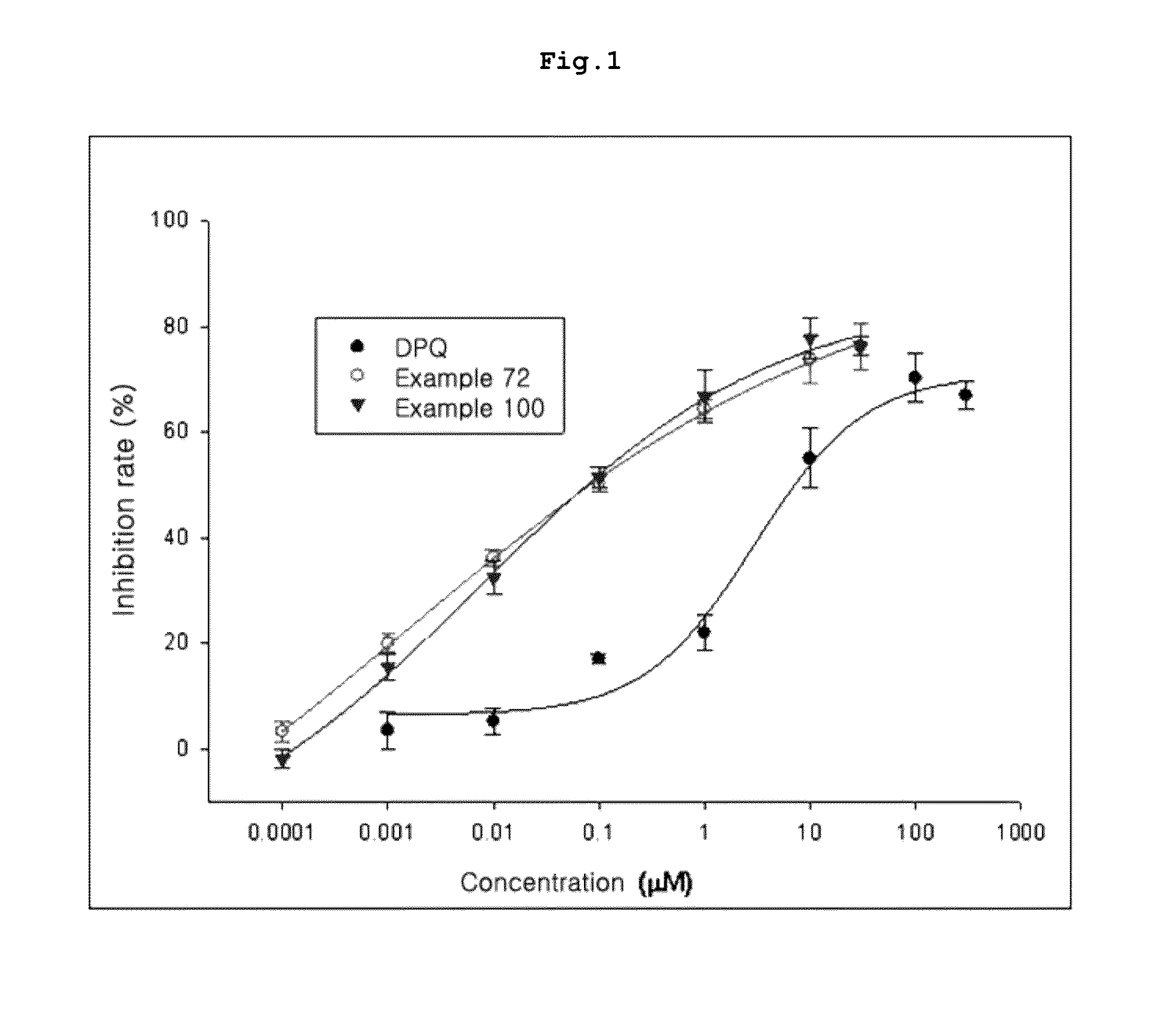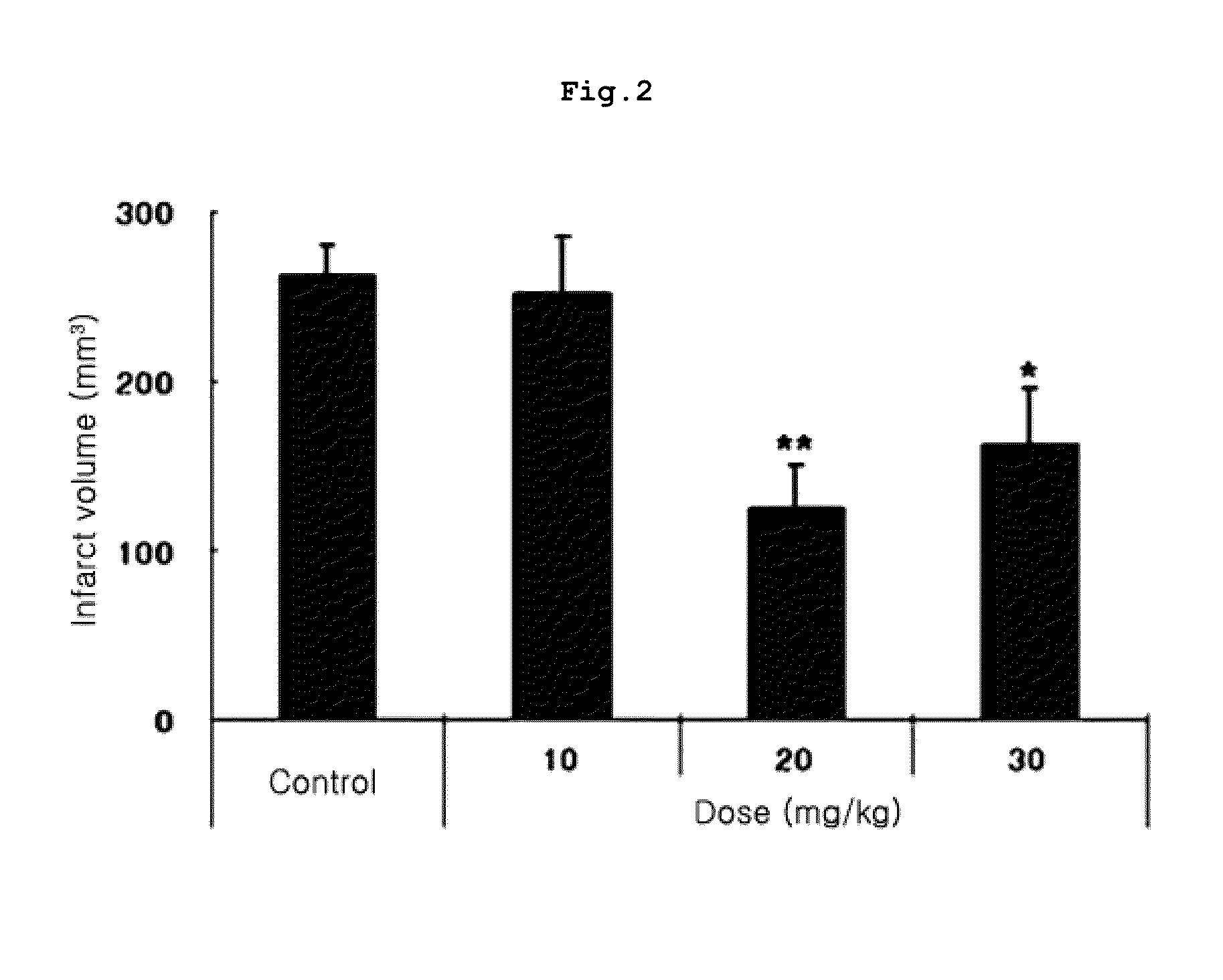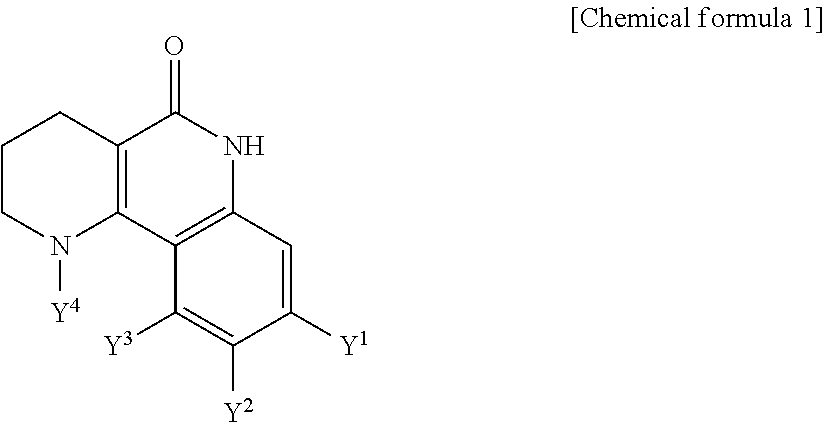Tricyclic derivative or pharmaceutically acceptable salts thereof, preparation method thereof, and pharmaceutical composition containing the same
a tricyclic derivative and pharmaceutically acceptable salt technology, applied in the field of tricyclic derivatives, can solve the problems of lack of oxygen in neurons, significant decrease of ndasup>+/sup> concentration, and significant deficiency, and achieve the effect of inhibiting activity and effectively using
- Summary
- Abstract
- Description
- Claims
- Application Information
AI Technical Summary
Benefits of technology
Problems solved by technology
Method used
Image
Examples
example 1
Synthesis of 8-Methoxy-1,2,3,4-tetrahydrobenzo[h][1,6]naphthyridine-5(6H)-one hydrochloride
Step 1: Synthesis of 2-Chloro-N-(3-methoxyphenyl)nicotine amide
[0385]
[0386]To a stirred solution of 2-chloronicotinic acid (500 mg, 3.17 mmol) in anhydrous dichloromethane (10 ml) was added dropwise oxalyl chloride (0.407 ml, 4.76 mmol) at a room temperature. A drop of anhydrous N,N-dimethylformamide was added and the reaction mixture stirred for 2 hours at a room temperature. Once the reaction was completed, intermediate product, i.e., 2-chloronicotinyl chloride was obtained with vacuum-concentration. Anhydrous dichloromethane (10 ml) was added, and then 3-anisidine (0.390 ml, 3.49 mmol) in anhydrous dichloromethane (5 ml) was added dropwise at 0° C. to a solution of the above mixture. Triethylamine (0.885 ml, 6.347 mmol) was added and the mixture was stirred for one hour at 0° C. Once the reaction was completed, water was added and the resultant mixture was extracted with dichloromethane. Th...
example 2
Synthesis of 10-Methoxy-1,2,3,4-tetrahydrobenzo[h][1,6]naphthyridine-5(6H)-one hydrochloride
[0405]
[0406]10-methoxy-6-(4-methoxybenzyl)benzo[h][1,6]naphthylidine-5(6H)-one (244 mg, 0.70 mmol) prepared in step 3 of Example 1 was reacted in the same manner as that of steps 4 to 6 of Example 1 to obtain the title compound (115 mg, yield: 61%, white solid).
[0407]1H NMR (400 MHz, DMSO-d6); δ 12.02 (s, 1H), 8.46 (br, 1H), 7.48 (t, J=8.0 Hz, 1H), 7.05 (dd, J=0.8 Hz, 8.4 Hz, 1H), 6.84 (dd, J=0.8 Hz, 8.4 Hz, 1H), 3.94 (s, 3H), 3.42-3.40 (m, 2H), 2.57-2.54 (m, 2H), 1.80-1.77 (m, 2H)
example 3
Synthesis of 9-Methoxy-1,2,3,4-tetrahydrobenzo[h][1,6]naphthyridine-5(6H)-one hydrochloride
[0408]
[0409]Except that 4-anisidine was used instead of 3-anisidine in step 1, the same manner as in Example 1 was applied to obtain the title compound.
[0410]1H NMR (400 MHz, DMSO-d6); δ 11.76 (s, 1H), 7.83 (br, 2H), 7.50 (d, J=2.0 Hz, 1H), 7.36 (d, J=8.8 Hz, 1H), 7.20 (dd, J=9.2 Hz, 2.4 Hz, 1H), 3.81 (s, 3H), 3.90 (t, J=5.2 Hz, 2H), 2.55 (t, J=5.6 Hz, 2H), 1.84-1.81 (m, 2H)
PUM
| Property | Measurement | Unit |
|---|---|---|
| weight % | aaaaa | aaaaa |
| temperature | aaaaa | aaaaa |
| temperature | aaaaa | aaaaa |
Abstract
Description
Claims
Application Information
 Login to View More
Login to View More - R&D
- Intellectual Property
- Life Sciences
- Materials
- Tech Scout
- Unparalleled Data Quality
- Higher Quality Content
- 60% Fewer Hallucinations
Browse by: Latest US Patents, China's latest patents, Technical Efficacy Thesaurus, Application Domain, Technology Topic, Popular Technical Reports.
© 2025 PatSnap. All rights reserved.Legal|Privacy policy|Modern Slavery Act Transparency Statement|Sitemap|About US| Contact US: help@patsnap.com



